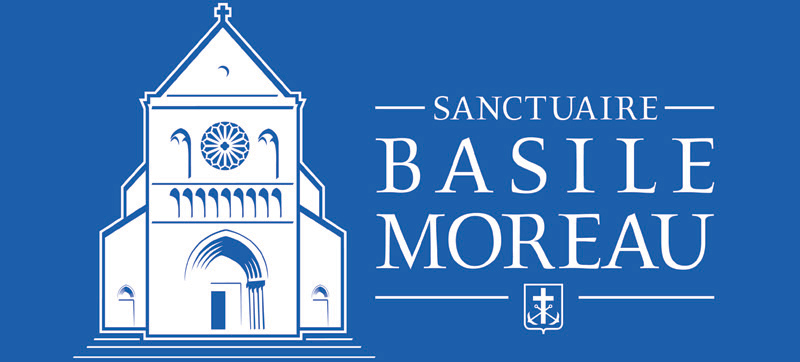Saint Julien Cathedral
The story of Blessed Basil Moreau is intimately connected to the history of the Diocese of Le Mans – a history that dates back to the foundation of the diocese when Saint Julien, first bishop of Le Mans, evangelized this region in the 4 th century.
Around the year 600, another bishop, Saint Bertrand, established the first Holy Cross church to serve pilgrims traveling to the Monastery of Saints Peter and Paul (the present day church of Notre-Dame de la Couture), and, it is said, to house a relic of the true Cross. Located not far from the site of the present-day Holy Cross church, Saint Bertrand’s church of Holy Cross gave the local area it’s name, and thus, the name of Moreau’s congregation many centuries later.
A glorious Cathedral
The Cathedral of Saint Julien, seat of the Diocese of Le Mans, is one of the finest examples of Gothic-Roman architecture in all of France. The current cathedral was built gradually over the course of the 11th through 15th centuries. Pope Urban II consecrated the cathedral (in its early stages) when he came to Le Mans to preach the first Crusade in the year 1096.
Among the many highlights in the Cathedral of Saint Julien is the stained glass window of the Ascension. Dating from the early 12 th century, it is the oldest stained glass window in its original setting in all of France, and perhaps even in all the world.
Another highlight is the vaulted ceiling of the Chapel of the Virgin Mary. Forty-seven angel musicians are depicted. The paintings, which date from the 14th century, had been covered over and were only rediscovered in 1842.
Historical persons
The cathedral contains the tombs of people of note. It was also the site of the baptism of Henry II, king of England, and of the marriage of his parents Geoffrey of Anjou and the Empress Matilda, daughter of King Henry I.
In the cathedral crypt can be found the tombs of many bishops of Le Mans, including those who played a significant role in the life of Basil Moreau and in the history of the Congregation of Holy Cross:
- Bishop Michel-Joseph von Pidoll von Quintenbach (1802-1819), who admitted Basil Moreau to the major seminary in 1816, gave him tonsure on September 18, 1816, and admitted him to minor orders on July 30, 1818;
- Bishop Claude de la Myre-Mory (1820-1829), who ordained Basil Moreau a priest and who, recognizing his gifts for the training of future priests, assigned him to Paris for supplementary formation with the Sulpicians;
- Bishop Philippe Carron (1829-1834), who was the first to approve the association of auxiliary priests (precursor of the Priests of Holy Cross) and who, “discerned in [Father Moreau] a man of zeal and oriented him toward activities which stretched far beyond the horizon of the major Seminary”. (Catta, 109);
- Bishop Jean-Baptiste Bouvier (1834-1855), who had been Moreau’s superior at the major seminary in Le Mans, and who, despite his later reservations, supported the early initiatives of Holy Cross, including approving Father Moreau as superior of the Brothers of Saint Joseph, authorizing a rule for the auxiliary priests, and blessing the cornerstone of the church of Our Lady of Holy Cross;
- Bishop Jean-Jacques Nanquette (1855-1862), whose position in favor of Father Moreau and of his Congregation of Holy Cross paved the way for papal approbation and who presided at the Mass of consecration of the church of Our Lady of Holy Cross;
- Bishop Charles Fillion (1862-1874), who, in a time of division that threatened the Congregation, reminded its members of the need to “surround their founder with respect and obedience until the end…”;
- Bishop Georges Cardinal Grente (1918-1959), who supported the Congregation of Holy Cross’ efforts to reacquire the church of their Founder, eventually presided over its re-consecration, and introduced Moreau’s cause for eventual canonization.
Blessed Basil Moreau and the Cathedral
As a priest of the Diocese of Le Mans, Father Moreau was very familiar with the Cathedral of Saint Julien. He was named an honorary canon of the cathedral by Bishop de la Myre-Mory, when he was only 26. This same bishop ordained Basil Moreau subdeacon on May 27, 1820, and deacon on April 7, 1821. Both of these rites occurred in the cathedral. Moreau’s ordination to the priesthood (August 12, 1821) took place in the Chapel of the Visitation.
It was in the sacristy of the cathedral where, after celebrating his morning Mass one day in early October 1836, a layman (Monsieur Barré) approached Moreau and offered him the use of his house as a residence for his auxiliary priests and as a primary boarding school until work could be completed on the Institution Notre-Dame de Sainte-Croix on the nearby “de Lisle property”.
The current bishop of the Diocese of Le Mans is Monsignor Yves Le Saux. He has served in this role since 2008. On September 21, 2014, he presided over the establishment of the Shrine of Blessed Basil Moreau at the church of Notre-Dame de Sainte-Croix.
“Let us thank Divine Providence for the illustrious example given to the church of Le Mans, since she has for founder a holy bishop who had the joy of receiving his mission from the very mouth of the prince of the Apostles, and let us honor his patronage by a special devotion.”
(Blessed Basil Moreau, speaking of Saint Julien, patron of the Diocese of Le Mans)



